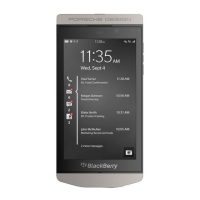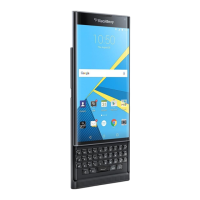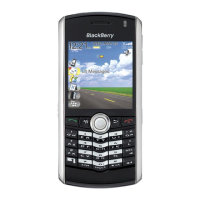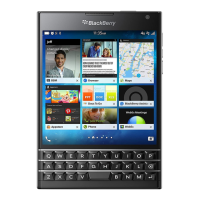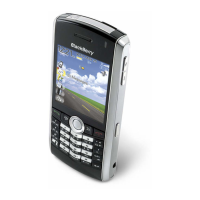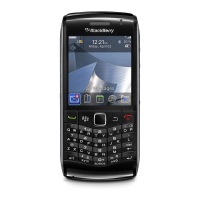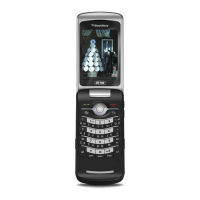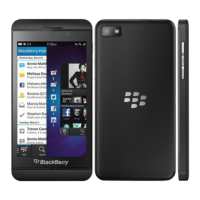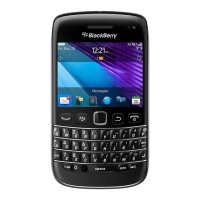Do you have a question about the Blackberry Porsche P'9983 and is the answer not in the manual?
Introduces new features in BlackBerry 10 OS version 10.3.
Access work and personal data from a computer or tablet.
Perform tasks using natural language voice or text commands.
Requirements and initial steps for setting up a new BlackBerry 10 device.
Managing BlackBerry ID for accessing services and transferring data.
Options and methods for transferring data to a new BlackBerry 10 device.
Basic operation of making and receiving calls, using call features.
Detailed steps for making and receiving calls, including speed dial.
Personalizing device sounds and alerts.
Information on standard and visual voicemail services.
Overview of how the Hub connects to various communication services.
Lists keyboard shortcuts for navigating and managing messages in the Hub.
Adding and configuring email, social networking, and other accounts.
Navigating and finding messages within the BlackBerry Hub.
Adjusting the volume for music and media playback.
Capture high-quality pictures and videos with various shooting modes.
Organize, edit, share, and display pictures taken on the device.
Play, edit, organize, and display video content.
Play and manage music, create playlists, and adjust audio settings.
Overview of device customization options for personalized control.
Using the virtual keyboard for efficient text input.
Changing display, typing, and voice input languages.
Using media cards for additional storage and transferring files.
Managing the device and computer connection with BlackBerry Link.
Managing apps by moving, creating folders, or deleting them.
Overview of the Assistant's capabilities for task management.
Overview of the Calendar app's functionality.
Managing contacts and integrating them with other apps.
Managing alarms, world clock, stopwatch, and timer.
Finding and downloading apps and games.
Using Maps, GPS, and Compass for navigation.
Browsing the Internet, streaming video, and managing downloads.
Viewing, saving, zipping, and sharing files and folders.
Performing calculations, conversions, and tip calculations.
Quickly switching between personal and work environments.
Overview of BlackBerry Balance for separating work and personal data.
Securing the work space with a password.
Staying connected and interacting with the device from a computer or tablet.
Using the Remember app for collecting, managing, and categorizing information.
Using locks, PINs, and passwords to protect the device.
Managing BlackBerry ID for accessing services and transferring data.
Using a single password for device and work space with BlackBerry Balance.
Obtaining and using unlock codes for SIM cards.
Setting and managing SIM card PINs.
Putting the device to sleep with the Power/Lock key.
Setting a device password to protect data.
Features for finding and protecting the device if lost or stolen.
Adjusting security for apps, parental controls, and data wiping.
Controlling app access to device information and features.
Performing a security wipe to permanently delete device data.
Restricting access to apps, features, and content via parental controls.
Using smart cards for device unlock and secure messaging.
| Keyboard | QWERTY |
|---|---|
| SIM | Nano-SIM |
| Protection | Corning Gorilla Glass 3 |
| OS | BlackBerry OS 10.3 |
| CPU | Dual-core 1.5 GHz Krait |
| GPU | Adreno 225 |
| Video | 1080p@30fps |
| Selfie camera | 2 MP |
| Video (Selfie) | 720p@30fps |
| Loudspeaker | Yes |
| 3.5mm jack | Yes |
| Bluetooth | 4.0, A2DP, LE |
| GPS | Yes, with A-GPS |
| NFC | Yes |
| Radio | No |
| USB | microUSB 2.0 |
| Sensors | Accelerometer, gyro, proximity, compass |
| Status | Available |
| Weight | 140 g |
| Size | 3.1 inches |
| Resolution | 720 x 720 pixels |
| Card slot | microSDXC (up to 128 GB) |
| Internal | 64GB 2GB RAM |
| Main Camera | 13 MP |
| Features | LED flash |
| WLAN | Wi-Fi 802.11 a/b/g/n, dual-band, hotspot |
| Battery | 2100 mAh |
| Colors | White |
| Announced | September 2014 |
